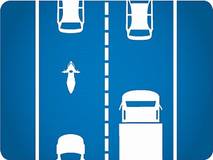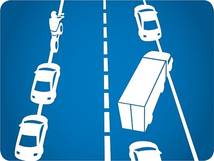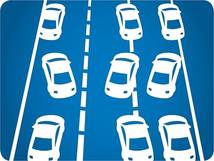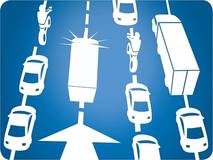Security
Germany
Phone number for emergency calls in Germany: 112
Polizeipräsidium Oberbayern Süd
Verkehrsmeldestelle Bayern (VMS BY)
Kaiserstrasse 32
83022 Rosenheim
Phone no.: 0049 (0)8031 200 1285 (24-hour service)
pp-obs.pp.vms@polizei.bayern.de
ADAC (Allgemeiner Deutscher Automobil-Club) emergency calls:
http://www.adac.de/mitgliedschaft/telefonnummern_notruf/default.aspx
- Mobile phone-fixed line network: 0 180 2 22 22 22
- Mobile phone: 22 22 22
- Phone no. in case of sickness or injury: +49 89 76 76 76
http://www.gdv-dl.de/services-notruf.html
0800 NOTFON D is the emergency mobile phone number of German motor vehicle insurers. It is a freephone number and is in operation round the clock every day of the year. 0800 NOTFON D (0800 668366 3) can be called by simply entering the corresponding characters on a mobile phone keyboard. It is not necessary to record a number – simply enter area code 0800 and the name NOTFON D0800 NOTFON D (0800 668366 3).
Tunnel safety
Transiting through tunnels safely
Having the best possible safety installations in road tunnels is one way of ensuring that tunnels are as safe as possible. By driving correctly, road users can make tunnels even safer. Below is a series of suggestions to ensure an accident-free journey. Also included are instructions on what to do in the event of an incident inside a tunnel.
Entering and driving through tunnels
- Switch on the headlights, take off your sunglasses und fold up the sun visor
- Listen to the traffic reports on the radio (in Austria, for example, the radio station Ö3 or one of the country-wide regional or private radio stations)
- If necessary, switch on your windscreen wipers (windscreens can quickly fog up in tunnels)
- Pay attention to traffic signals and information panels
- Pay attention to traffic lights and road markings
- Keep a safe distance
- Stick to the speed limit
- Stop only in the emergency bays, do not turn around in the tunnel.
If traffic comes to a standstill
- Do not turn around or reverse.
- Switch off the engine
- Listen to the traffic reports on the radio in Austria, for example, the station Ö3 or country-wide regional or private radio stations)
- Keep a safe distance from the vehicle in front
- Pay attention to traffic signals and information panels
- Pay attention to traffic signs and road markings
- If applicable, follow the instructions of the tunnel personnel.
If you have a breakdown or there is an accident in the tunnel
- Switch on your hazard lights
- Park your vehicle on the hard shoulder, in an emergency bay or along the right edge of the road
- Put on your high-visibility vest
- If after a breakdown or accident the vehicle is located outside an emergency bay it should be signalled using a hazard warning triangle
- Switch off the engine and leave the key in the ignition
- Use emergency call facilities (phone, “SOS“ or “fire“ buttons).
- DO NOT USE YOUR MOBILE PHONE
- Administer first aid
If there is a fire
- Switch on your hazard lights
- If your vehicle is on fire: if possible, leave your vehicle on the hard shoulder, in the emergency bay or on the right-hand edge of the road to allow the emergency services to pass
- Switch off the engine, leave the keys in the ignition and immediately leave your vehicle
- If possible, extinguish the fire while it is still small, using the fire extinguishers and hoses available in the tunnel
- Administer first aid
- Use emergency call facilities (telephone, the “SOS“ or “fire” buttons)
- DO NOT USE YOUR MOBILE PHONE
- Help others reach safety
- If there is a lot of smoke, immediately leave the tunnel using the escape routes and follow the instructions of the tunnel personnel
Safety notices
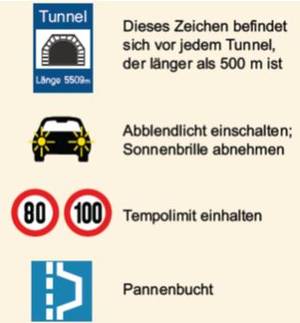 | 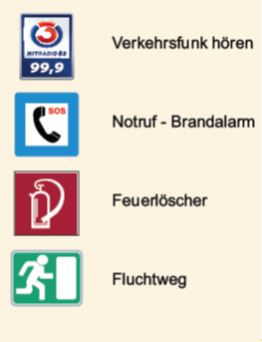 |
|---|
Left-hand column, from top to bottom
- This sign can be found at the entrance to any tunnel longer than 500 m
- Switch on dipped headlights; remove sunglasses
- Speed limit
- Emergency bay
Right-hand column, from top to bottom
- Listen to traffic reports on the radio
- Emergency call and fire alarm
- Fire extinguisher
- Escape route
Tunnel equipment
Emergency call facilities in the tunnel and near the tunnel mouth
Emergency call facilities are located in the tunnel in walk-in bays situated at intervals of approximately 125 m. Near the mouths of the tunnel the emergency call facilities are located in a closed booth. The emergency call bay or booth is lit from the inside and the door handle activates a contact when opened. A handset is available for making emergency calls. In addition, manual alarm buttons are provided to signal SOS or a fire.
Fire-fighting stations
Fire-fighting stations located every 125 to 150 metres include points for drawing fire-extinguishing water. The fire-fighting stations are equipped in consultation with the local fire departments. Every fire-fighting station is provided with a fire hydrant.
Escape and rescue routes
Escape and rescue routes are cross-cut shafts leading to the adjacent tunnel or to shafts leading from the tunnel interior to the outside. They are signposted in the tunnel. Signs distinguish between:
- Cross-cut shafts suitable for emergency vehicles, located at intervals of no more than 1,000 metres.
- Cross-cut shafts for use by pedestrians are located every 250 to 500 metres.
Stopping places/emergency bays
At most every 1,000 metres emergency bays are situated on the right-hand side, in the direction of travel, in which vehicles can be parked in the event of a breakdown or accident.
Ventilation systems
Under normal operating conditions ventilation systems inside tunnels ensure that pollutant concentrations do not exceed the lower limits.
A distinction is made between longitudinal and transverse ventilation systems. In longitudinally ventilated tunnels ventilation is by jet fan ventilators mounted on the tunnel ceiling. In tunnels with transverse ventilation, ventilation is by adjustable axial ventilators and exhaust-air louvers mounted in the intermediate ceiling. In the event of a fire, the louvers are used for local extraction.
Modern tunnel monitoring from high-tech control rooms
Tunnel installations are permanently monitored by specially trained operators. Control centres are equipped to monitor several tunnels at once. Automated systems such as video monitors, video image analysis and fire alarm system ensure a rapid response in the event of an incident.
Further information:
Rescue lanes
In Austria it is compulsory for all vehicles, such as cars, motor cycles, HGVs and coaches/buses, always to form a rescue lane when traffic is backed up or is moving very slowly. A rescue lane is defined as a space between the individual lanes of a motorway or expressway or other rapid road. This rule applies to all Austrian motorways and expressways or rapid roads with a central barrier, irrespective as to whether the carriageway consists of two, three or four lanes.
Caption: Traffic stopped? Form a rescue lane!
How to form a rescue lane:
All vehicles driving in the left lane have to move as far to the left of their lane as possible. All vehicles in the right-hand lane move as far to the right as necessary. In doing so vehicles should make use of the hard shoulder (emergency lane). If there are more than two lanes, the following rule applies: vehicles in the left lane move to the left, all the other vehicles to the right.
Captions:
- Forming a rescue lane on a two-lane road
- Forming a rescue lane on a road with more than two lanes
Further information:
http://rettungsgasse.com/web/guest/on-the-way/road-traffic-safety/emergency-corridor
www.asfinag.at/verkehrssicherheit/sicherheitslexikon

